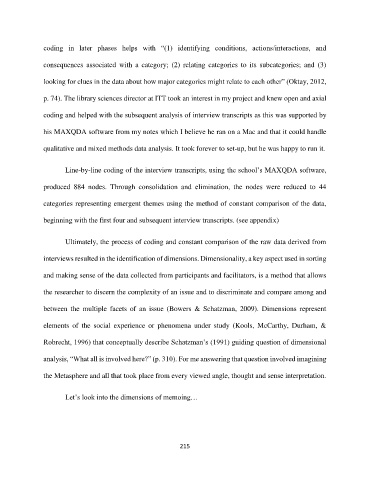Page 234 - Mike Ratner CC - WISR Complete Dissertation - v6
P. 234
coding in later phases helps with “(1) identifying conditions, actions/interactions, and
consequences associated with a category; (2) relating categories to its subcategories; and (3)
looking for clues in the data about how major categories might relate to each other” (Oktay, 2012,
p. 74). The library sciences director at ITT took an interest in my project and knew open and axial
coding and helped with the subsequent analysis of interview transcripts as this was supported by
his MAXQDA software from my notes which I believe he ran on a Mac and that it could handle
qualitative and mixed methods data analysis. It took forever to set-up, but he was happy to run it.
Line-by-line coding of the interview transcripts, using the school’s MAXQDA software,
produced 884 nodes. Through consolidation and elimination, the nodes were reduced to 44
categories representing emergent themes using the method of constant comparison of the data,
beginning with the first four and subsequent interview transcripts. (see appendix)
Ultimately, the process of coding and constant comparison of the raw data derived from
interviews resulted in the identification of dimensions. Dimensionality, a key aspect used in sorting
and making sense of the data collected from participants and facilitators, is a method that allows
the researcher to discern the complexity of an issue and to discriminate and compare among and
between the multiple facets of an issue (Bowers & Schatzman, 2009). Dimensions represent
elements of the social experience or phenomena under study (Kools, McCarthy, Durham, &
Robrecht, 1996) that conceptually describe Schatzman’s (1991) guiding question of dimensional
analysis, “What all is involved here?” (p. 310). For me answering that question involved imagining
the Metasphere and all that took place from every viewed angle, thought and sense interpretation.
Let’s look into the dimensions of memoing…
215

